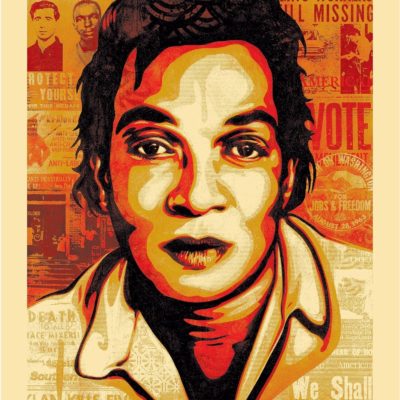Eight years ago, street-art entrepreneur Shepard Fairey’s “Hope” image of President Obama swelled support for the then-candidate and inspired a bevy of mildly annoying imitations. Fairey, 46, continues to balance his commercial work with his passion for projects that he hopes can have a social impact. His latest is “American Civics,” set to be unveiled in the next few weeks at the Mansion on O Street in Washington. For “Civics,” Fairey adapted five photos by Jim Marshall, known for capturing Jimi Hendrix at the 1967 Monterey Pop Festival and Johnny Cash in 1968 at Folsom Prison, in California. Ten percent of the print-sale proceeds will go to the NAACP Legal Defense and Educational Fund. We spoke with Fairey by phone recently from Los Angeles.
“Jim was really great in capturing these important moments,” Fairey says. “There are a few variables to great photography. One is composing a great picture. The other is being in the right place in the right time. Jim was able to do both. I feel like I’m able to amplify what he was doing with a large twist. This is absolutely amazing raw material to work with. It’s incredibly meaningful, and I want to serve it properly with what I’m doing. I also want to bring something new with it as well.”
MASS INCARCERATION

(Left): Jim Marshall’s photograph of Johnny Cash taken at Folsom Prison, California, 1968. (Right): Illustration created by Shepard Fairey. (Jim Marshall Photography LLC/Photo Illustration by Shepard Fairey based on work by Jim Marshall)
“In the past, I was doing Johnny Cash images for art or commercial products. In this case, Johnny Cash has a different use. It’s a gateway. If you look at the images woven into the image, there’s Martin Luther King’s mug shot. There’s the prisoner’s bill of rights in the corner. There’s some references to ‘Public Enemy’ that were [in] headlines back in Al Capone’s time. But for me, it also references the [hip-hop] group Public Enemy, which has a song, ‘Black Steel in the Hour of Chaos,’ which is about a prison break.”
WORKERS’ RIGHTS

(Left): Jim Marshall photographed Cesar Chavez during Chavez’s 300-mile march to the California State Capitol in Sacramento to bring widespread public attention to farmworkers’ causes, civil rights, political representation for racial minorities, and environmental justice. (March 1966). (Right): Illustration created by Shepard Fairey of Marshall’s photograph. (Jim Marshall Photography LLC/Photo Illustration by Shepard Fairey based on work by Jim Marshall)
“I remove the guy next to Cesar Chavez. I made him sticking his head up a little higher, so he’s a little bit more in the negative space. I collaged a lot of other images of Jim Marshall’s other photos in the march, things that reinforced the narrative. That’s all collaged by hand and all painted with stencils and spray paint and a brush.”
GUN CULTURE

(Left): Jim Marshall lived in the distinctive Greenwich Village neighborhood of New York from 1962 to 1964, working with major record labels and news magazines. He shot many of his iconic Bob Dylan photos there. The Village also offered poignant scenes of street life, which Jim captured with his Leica, including a kid resting after playing “good guys vs. bad guys.” (1963). New York City. (Right): Illustration created by Shepard Fairey of Marshall’s photograph. (Jim Marshall Photography LLC/Photo Illustration by Shepard Fairey based on work by Jim Marshall)
“This obsession with guns is ingrained, and it starts at a young age. And that kid could have innocently been playing ‘good guys and bad guys,’ but it also has a deeper implication of just how culturally ingrained guns are and how that allows gun ownership to trump safety. The sidewalk is the American flag. That to me — it’s such a loaded symbol — and sometimes that can be something that is an easy gimmick, but I really think it’s meaningful in this because it’s almost [as if] you’re un-American if you don’t support gun rights.”
VOTING RIGHTS
“That one is probably the most intense of the images, if you know the backstory. Fannie Lee Chaney, who was the mother of James Earl Chaney, who was killed along with two white friends while trying to register black people to vote. So you know about it — a lot of people know about it — but this is an intimate portrait of James Earl Chaney’s mom the day she found out her son had been killed. There’s a sadness and resolve in the image, but there’s also a humanity.”
TWO AMERICAS

(Left): On assignment in the winter of 1963, Jim Marshall embedded himself with a coal mining family in Hazard, Kentucky. He resided with the family, sleeping in their home and sharing their food. And he photographed their lives and daily struggles to survive in dire poverty. The author of the article remained in New York, and believing that the writer was judgmental about the people of Hazard, Jim refused to allow the use of his photographs for the story. (Right): Illustration created by Shepard Fairey of Marshall’s photograph. (Jim Marshall Photography LLC/Photo Illustration by Shepard Fairey based on work by Jim Marshall)
“In this piece, I completely changed the composition. I have the mother behind the kids as if she’s leaning over them in a protective way. In the original photograph, she’s off to the side. Also, a lot of the things I’ve woven into the collage and the background are really important. I’ve tried to render the window so it’s light outside, [because] it’s very dark outside and doesn’t come across in the original photo.”

